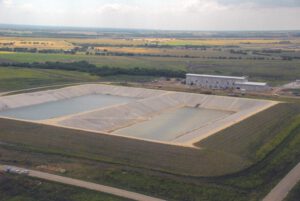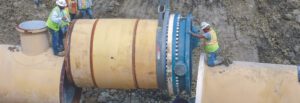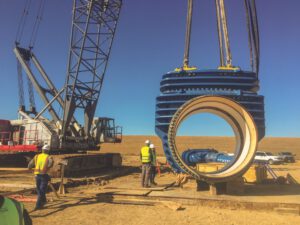The Tarrant Regional Water District has been providing flood-control and water supply services to the city of Fort Worth, Texas, for nearly 100 years. The rapid growth of Fort Worth and its sister city, Dallas, has necessitated the construction of ambitious new reservoir and pipeline projects. Most recently, Tarrant Regional Water District and the City of Dallas have collaborated on the immense Integrated Pipeline (IPL) project, which is projected to supply 350 million gallons of water per day to Fort Worth, Dallas, and other water users.
In this interview, Municipal Water Leader Managing Editor Joshua Dill speaks with Alan Thomas, the deputy general manager of the Tarrant Regional Water District, and Dan Buhman, the assistant general manager, about the history of the district, the purpose and scope of the IPL, and the challenges of building this historic project.
Joshua Dill: Please tell us about your professional backgrounds.
Alan Thomas: I have a degree in accounting from the University of Texas at Arlington; at the Tarrant Regional Water District, I started out in the accounting department and moved up from there. I took over administration at one point, and in early 1990 I took over operations. That position evolved into the assistant general manager position; later on I became deputy general manager.
Dan Buhman: I studied civil engineering at Brigham Young University and then completed graduate studies at Colorado State University. After my graduate work, I was a consultant for about 14 years. For a lot of that time, I worked with Tarrant Regional Water District, doing long-range water supply planning. It was a natural fit to join up with the water district: I joined as the assistant general manager 5 years ago.
Joshua Dill: Would you tell us about the history of the Tarrant Regional Water District?
Alan Thomas: We were created back in 1924, primarily for flood control and water supply. In 1930, we built two reservoirs on the west part of the Trinity River, one at Eagle Mountain and the other at Bridgeport. When the big flood of 1949 happened, we issued bonds and upgraded the levee system in Fort Worth on the west side of the Trinity. The levees are built to protect against an 800-year flood and to prevent the kind of flooding that occurred in 1949. Once the area started growing, the Eagle Mountain Lake and Lake Bridgeport Reservoirs were not sufficient. There was not enough rainfall in the West Fork watershed. In the 1960s and 1970s, we moved east and built the Cedar Creek Reservoir and pumped water back into Fort Worth via our first pipeline, which was 72 inches in diameter. Later on, we expanded that pipeline to make it high capacity by adding one more pumping station and expanding the existing pump station. Then we built another reservoir in east Texas, the Richland Chambers Reservoir. Just to give you a comparison, Lake Bridgeport is about twice as big as the Eagle Mountain Lake Reservoir; Cedar Creek is about twice as big as Lake Bridgeport; and Richland Chambers, the last reservoir that we built, is about twice as big as Cedar Creek and is the third-largest reservoir in Texas. When demand dictated, we built pipelines and high-capacity pump stations to get water up to the metroplex. We add to our system as demand dictates and try to keep the costs as low as possible so that everyone can afford it.

It is expensive to pump water from east Texas, and our pumping capacity is not able to meet real-time demand. To address that issue, in 1998 we completed something we call the Benbrook connection, which moves water all the way from east Texas to the Benbrook Lake Reservoir, which is owned by the U.S. Army Corps of Engineers. We move the water during the winter so that it will be in Tarrant County, where 95 percent of our water is used, when summer hits. The next step was to build the Eagle Mountain connection in the mid 2000s, which takes water all the way from east Texas to the Eagle Mountain Lake Reservoir. The City of Fort Worth, our largest customer, has two plants that are fed by Eagle Mountain Lake. Then it was time to build a third pipeline. Our plans for east Texas have always included three pipelines: one from the Cedar Creek Reservoir, one from the Richland Chambers Reservoir, and one that would bring in supply from both Cedar Creek and Richland Chambers. We realized that if we built it according to our original plans, we would be putting all of our eggs in one basket. One natural disaster at one pump station would put 85 percent of our water supply out of commission. We did a study and came up with a route that goes south of the existing pipeline and actually puts us on a separate power grid.
During the same period of time, the City of Dallas was working on a similar problem: It had contracts for the water in Lake Palestine and needed to bring that water to its customers. We decided to work together on what is now the IPL. We are on a different power grid, so there is no single point of failure, and Dallas is sharing the cost for a large portion of the pipeline. The pipeline is designed for a capacity of 350 million gallons per day (MGD); our capacity is 200 MGD, and Dallas’s is 150 MGD. If one party is not using its full capacity, the other has the right to use the difference. As for construction cost sharing, everything east of Cedar Creek Reservoir is 100 percent paid for by Dallas and everything north and west of the city of Midlothian is 100 percent paid for by Tarrant Regional Water District.
Joshua Dill: How large is the area that you serve, and how many people live there?
Dan Buhman: We supply water to over 2 million people in an area larger than Rhode Island and a just a little bit smaller than Connecticut. It comprises 11 counties. We also provide flood protection to over $1 billion in property throughout Fort Worth, and recreation infrastructure, like trails, throughout our levee system.
Joshua Dill: What purpose does the IPL project serve?
Dan Buhman: We had more water in our reservoirs in east Texas than we had pipelines to move that water. Our strategy is to build the reservoirs first and phase in the pipelines as demand grows. We already had one pipeline from the Cedar Creek Reservoir and one pipeline from the Richland Chambers Reservoir, and we needed a third pipeline that would connect those two and allow us to fully convey all that water. It also has a little extra capacity for peak or high-demand periods. As Alan explained, it is a joint project with the City of Dallas: Growing demand also dictated that a pipeline to the Lake Palestine Reservoir be built. This project connects all the water supplies in this fast-growing metro area. It brings new water to the area, and it adds a level of reliability and resiliency to our system. We have begun our testing phase, and we are pumping in
the pipeline currently. We will have a grand opening in the spring to celebrate the successful startup of this project.
Joshua Dill: What were the changing conditions that made this project necessary?

Dan Buhman: Because of growing demand, we were maxing out our system. There were times when we could not take a pipeline down for maintenance because we were pumping at the maximum level. Obviously, that was during times of drought and therefore high demand. The original plan was to have all the pipelines done by 2018. Our conservation efforts have been so successful that we have been able to defer segments of the pipeline until much farther into the future when demand dictates the need for those segments. Our demand-growth line is much flatter than it used to be because of efforts to use water more efficiently in the area.
Joshua Dill: How large is the new IPL project in terms of length and size of pipe?
Alan Thomas: The entire project, including the segment from Lake Palestine and the Dallas segment, involves about 150 miles of pipeline. The first phase of the project, which is about to start operating, is a little over 80 miles. All but about 12–15 miles of that is 108-inch pipe and the remainder is 84-inch pipe. There will be three booster-pump stations along the pipeline (only one of those is being built in the first phase).
Dan Buhman: The project involves three lake pump stations, three booster pump stations, and a balancing reservoir in the middle of the pipeline that will be able to store 450 million gallons. One booster pump station is online now and two more will come online in the future. The balancing reservoir is at the high point of the pipeline; basically, the water is pumped uphill to the balancing reservoir and from there it flows downhill to its major delivery points in Tarrant County. There are deliveries along the way as well.
Alan Thomas: We also have two smaller reservoirs near the booster pump stations that are 40 million gallons each. We may build two more in the future as well, depending on the demand on the system. This gives us more ground storage than we have ever had before. Our largest budget item is power; that kind of reservoir storage lets us take advantage of time-of-day pumping so that we can save money by pumping during off-peak hours. The sheer size of the pipeline means that we can pump a lot more water using the same amount of energy. The first phase of the pipeline will allow us to pump 20–40 MGD more while using the same amount of energy, and once we finish phase 2 of the project, which connects the Cedar Creek Reservoir, we will be able to pump about 120 MGD more
while consuming the same amount of energy as we do now. The savings on power costs will be a huge benefit.
Joshua Dill: Would you tell us about some of the challenges of working on such a large project in terms of design, engineering, and planning?
Dan Buhman: From the beginning, one of the challenges was bringing together Dallas and Tarrant Regional in a partnership. These are two different entities with different ways of doing things and different governing bodies. To come together and build a $2.3 billion water project required significant effort. There was a long planning effort to put together a partnership that was acceptable to both parties; to get both governing bodies on board; and to determine who was going to own it, operate it, and maintain it. Our effort to solve those challenges has been successful. Both partners were optimistic and worked well together in creating a partnership that has been extremely successful.
The other challenge has been that it is such a large project that we have had to split it up into a lot of different segments and give those segments to different engineering firms and contractors. We ended up hiring 10 prime engineering firms. Just putting together a program- management structure that could handle that complexity and that worked within the Tarrant Regional culture was a challenge. We are a technically sophisticated organization and do a lot of our own work, so bringing in a program manager who could work with us and handle that level of complexity was a big challenge. Producing design standards and technical standards for those teams to adhere to was a key to making the different segments work as one whole.
 Alan Thomas: We have had a few hiccups here and there, but overall, the project has gone smoothly. We have not had as many issues as I thought we would. We are in the process of starting up those booster stations, which will bring further challenges. Getting all the settings, gate closures, and valve closures right will be a challenge.
Alan Thomas: We have had a few hiccups here and there, but overall, the project has gone smoothly. We have not had as many issues as I thought we would. We are in the process of starting up those booster stations, which will bring further challenges. Getting all the settings, gate closures, and valve closures right will be a challenge.
Dan Buhman: Land acquisition was a significant challenge. We are buying easements for a 150-foot-wide right of way across 517 parcels, wide enough to accommodate 3 pipelines. It has required significant effort, but we only have 31 parcels left to acquire.
Alan Thomas: With the significant growth in our region, we know that land acquisition for public infrastructure will only get more difficult, so we are buying enough right of way to build pipelines in the future as well.
Joshua Dill: What advice do you have for water districts considering similar projects?
Alan Thomas: One piece of advice is to construct your system based not on what you need today, but on what you are going to need in the future. Having the foresight to plan for major upcoming projects and partnerships can be critical to success.
Dan Buhman: When you are planning, it is essential to get stakeholder engagement right from the beginning. Those stakeholders include your governance, partners on the project, and local officials. The beginning is often easy: People see the need for more water and give their approval to build something rather quickly. But there may come a time when you need to spend your political capital to move something forward. You want to build that capital from the beginning; you don’t want to need it and not have it.
Joshua Dill: What else would you like to tell our readers about this project?
Dan Buhman: We took an environmentally sustainable approach to this project. We did not have to mitigate any environmental damage because we avoided those impacts entirely. We also are not taking out any places of residence except for one: In all 517 parcels, only one residence is being relocated. We worked for a long time to ensure social and environmental sustainability. We do everything we can to work with landowners during land acquisition. We use eminent domain as a last resort, and even after we exercise that power, we continue to negotiate. The vast majority of the time, we strike a deal instead of going to court. I consider that social responsibility: working with landowners to make sure that they are justly compensated as we go through their property. We restore their property, and since we know we will have a long-term relationship with these landowners, we treat them fairly from the beginning.
We received an Envision Platinum Award for our work on this project, which makes it Envision’s highest-ranked linear pipeline ever. It is a reflection of our efforts to have a positive effect on the triple bottom line of environmental, social, and economic considerations. In addition to the project’s environmental accomplishments, the IPL received the highest scores for leadership/regional partnership; life-cycle cost considerations; energy efficiency; and sustainable, long-lasting design.
For more information about Tarrant Regional Water District, visit trwd.com.


